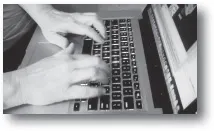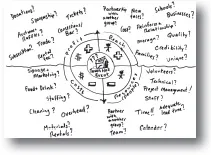
eBook - ePub
Discovering Media Literacy
Teaching Digital Media and Popular Culture in Elementary School
Renee Hobbs, David Cooper Moore
This is a test
Share book
- 256 pages
- English
- ePUB (mobile friendly)
- Available on iOS & Android
eBook - ePub
Discovering Media Literacy
Teaching Digital Media and Popular Culture in Elementary School
Renee Hobbs, David Cooper Moore
Book details
Book preview
Table of contents
Citations
About This Book
Give digital kids a voice!
Today’s kids are digital natives, but what’s the best way to help them become empowered and responsible communicators across different media? Discover insights and strategies specific to reaching children ages 5-12 in this guide from a nationally-acclaimed media literacy program. Readers will find:
- Thought-provoking lesson plans that reach students of all backgrounds and abilities
- Use of a wide range of technology tools, including the Internet, video, and mobile apps,
- An emphasis on online safety and development of essential critical thinking skills
- Materials for teacher professional development
Frequently asked questions
How do I cancel my subscription?
Can/how do I download books?
At the moment all of our mobile-responsive ePub books are available to download via the app. Most of our PDFs are also available to download and we're working on making the final remaining ones downloadable now. Learn more here.
What is the difference between the pricing plans?
Both plans give you full access to the library and all of Perlego’s features. The only differences are the price and subscription period: With the annual plan you’ll save around 30% compared to 12 months on the monthly plan.
What is Perlego?
We are an online textbook subscription service, where you can get access to an entire online library for less than the price of a single book per month. With over 1 million books across 1000+ topics, we’ve got you covered! Learn more here.
Do you support text-to-speech?
Look out for the read-aloud symbol on your next book to see if you can listen to it. The read-aloud tool reads text aloud for you, highlighting the text as it is being read. You can pause it, speed it up and slow it down. Learn more here.
Is Discovering Media Literacy an online PDF/ePUB?
Yes, you can access Discovering Media Literacy by Renee Hobbs, David Cooper Moore in PDF and/or ePUB format, as well as other popular books in Languages & Linguistics & Literacy. We have over one million books available in our catalogue for you to explore.
Information
Part I
Why Digital and Media Literacy Matters
1 | Digital and Media Literacy |
In this chapter, you’ll learn about
Digital and Media Literacy
- What is digital and media literacy?
- Why should we expand the concept of literacy to acknowledge the worlds of print, visual, audio, and interactive media in the elementary grades?
Technology Integration
- Why does technology integration support learning?
- How may it distract from meaningful learning practices in the classroom?
Bridging Classroom and Culture
- How can teachers use digital and media literacy to engage students’ interests and passions, and develop knowledge, competencies, and skills?
It was lunchtime, and Ms. Dominguez’s second-grade students had just finished eating. A few minutes remained for table talk before recess. Three girls had opened up their black-and-white composition notebooks and were pretending to use a laptop, tapping their fingers on the pages.
One little girl, Natalia, had propped up her composition notebook against her milk carton so that the top half of the page displayed a “screen” of sorts. Here, she had written the word “Facebook” and had sketched a close-up picture of herself. On the lower page of the notebook, she had drawn a keyboard, complete with small square boxes to represent keys, including the alphabet, space bar, return, shift, and enter keys.
Giving each other knowing glances around the lunch table, Natalia and the other girls were “typing” on their composition notebooks, pretending to be working on their laptops. As Ms. Dominguez surveyed her classroom, she took note of this activity, smiling to herself because, unbeknownst to the children, she also had briefly checked her own Facebook page using her cell phone at the teacher’s desk while eating her lunch that day.
GROWING UP WITH MEDIA AND TECHNOLOGY
All of us, children and adults alike, are growing up with more access to media and technology than at any point in human history. Well before they enter kindergarten, young children spend many hours with screen media. About half of all babies and toddlers under the age of two watch 2 hours of television per day. In 2011, a national survey showed that nearly one in three babies and toddlers has a TV in his or her bedroom, up from 19% just 6 years earlier.1
Although TV viewing is the most frequent screen activity of childhood, one fourth of young children’s screen time now includes the use of computers, handheld and console video game players, and other interactive mobile devices such as cell phones, iPods, and iPad-style tablet devices.2 Natalia, her mom, and her sister Sara like playing Angry Birds on the family cell phone or checking out what their other family members are posting on Facebook and Twitter.
More than half of all 5- to 8-year-olds have used an app (an application) on a mobile device of some sort, researchers tell us. And for Natalia, as with many young children, video game and computer use is a part of daily life, with one in five using a video game or a computer every day. Most children who use video games or computers begin when they are just 3½ years old.3
In her home in West Philadelphia, Natalia is among the 75% of children under the age of 8 who don’t often watch educational television programs like Sesame Street or Between the Lions on PBS. Instead, she enjoys the Toonzai block on Channel 57, the CW network in Philadelphia, which airs imported Japanese anime shows like Yu-Gi-Oh! and Dragon Ball Z Kai. Natalia’s family is among the 50% of low-income families who do not have access to cable or satellite television programming. In her house, the TV is on most of the time, even when no one is watching.
Because Natalia’s mom works a lot, she doesn’t get much opportunity for what is sometimes called co-viewing or joint media engagement, where parents or caregivers help support the use of TV shows, movies, video games, or the Internet explicitly as a tool for children’s learning.4 Natalia and her mom, Joyce, do watch “regular” television together, including Good Morning America, Entertainment Tonight, and American Idol, but generally this time together is a place of relaxation and escape. Neither Natalia nor her mom perceive it as a time for learning.
We still know relatively little about how digital technology and entertainment media make a positive contribution to children’s understanding of the political and social world.5 By watching TV and movies, Natalia has learned much about the world around her: She’s familiar with different types of family structures, recognizes the president, and knows about the types of jobs done by people in hospitals and in law enforcement. The many stories Natalia watches also shape her understanding of social relationships, including both prosocial behaviors like kindness, generosity, and helping others and antisocial behaviors like aggression, lying, and being mean to others.
Today, Natalia’s mom and her teachers aren’t thinking much about children’s TV time; they’re far more concerned about children’s use of the Internet and social media. Right now, we’re in a paradigm shift where all of us—young and old—are learning to adapt to rapid changes in media and communication technology.
When teachers like Ms. Dominguez notice the ways in which social media, popular culture, and digital media enter the lives of their students, they may have a sense of both the promise and the possibility but also the profound ways that these things may complicate classroom life. How could Ms. Dominguez use her own knowledge of social networks—and her students’ developing knowledge of how computers, laptops, and mobile devices work—in a way that somehow connects a rich digital media culture to the everyday business of teaching her students how to better understand and communicate in the world around them?
LEARNING, LITERACY, AND LIFE
Education supports the development of the whole human being: the head, the heart, and the spirit. As children grow and develop, they transform basic sensory experiences into thoughts, feelings, and ideas, gradually moving from simple reactions toward more complex and nuanced responses, translating experience into “a model of the world” through actions, images, and, finally, symbolic representation.6 Through active engagement with the process of meaning-making, children develop their identities as literate, social, emotional, and moral individuals.
What does it mean to be literate? For most of human history, to be literate meant to be effective as a speaker and a listener. The concept of rhetoric emerged more than 2,500 years ago as people discovered that certain ways of talking were more effective and powerful in achieving social power and influence. When the Gutenberg revolution brought printed books to a mass audience, the concept of literacy expanded to include the skills of reading and writing, which required many years of practice to master fully.
Today, people need to be able to “read” and “write” messages using symbols in a variety of forms. Each genre and medium of expression and communication demands certain learned competencies. For example, reading on screen, reading from a page, writing with a keyboard, and writing with a pencil are all practices that require particular skills. In this book, we’ll show how mass media, social media, popular culture, and digital media texts can be used to support the development of children’s reading, writing, speaking, listening, and communication skill development.
Talking About Popular Culture Builds Listening Comprehension
Children’s talk about popular culture and mass media is deeply tied to language development, comprehension, and expressive skills. For example, in hands-on work with media literacy in over 60 elementary schools in England, scholars found that film viewing and discussion activities promote high levels of talking and sharing in extended discourse. While watching, young children listen closely and are able to comprehend narratives and notice details about dialogue and music, plot, setting, and character.7
When children learn how to apply concepts like audience, message, purpose, and point of view to both familiar media (like TV shows and music) and unfamiliar media (like nonfiction textbooks and news articles), they strengthen their critical reading strategies.
Many children who are just learning to decode and comprehend print texts can demonstrate complex reasoning and sophisticated thinking skills using familiar visual or digital materials. Especially for those children who have become disengaged and alienated from school, getting a chance to display one’s funds of knowledge and reasoning skills with mass media, popular culture, and digital media activities enables children to bring their at-home media and technology experiences into the classroom. Not only are such practices engaging and motivating to young learners, but such connections are also at the heart of what real learning is all about.
Today, many communication competencies are needed to be effective in society. Digital and media literacy includes the ability to access, analyze, compose, reflect, and take action in the world. It’s a broad and expansive array of life skills. We think it’s absolutely essential for elementary educators to help strengthen children’s self-expression and advocacy, reasoning, critical thinking, and communication skills. Social development, self-confidence, conflict-resolution skills, and sensitivity to the social responsibilities of using 21st century technologies are habits of mind that enable children to thrive. The following list outlines the kind of competencies that are increasingly valued both inside and outside the classroom.
POWERFUL VOICES FOR KIDS: DIGITAL AND MEDIA LITERACY COMPETENCIES

Access
- Listening skills
- Reading comprehension
- Using appropriate technology tools
- Asking questions
- Gathering information using multiple sources
- Applying information to solve a problem

Analysis
- Understanding how symbols work and how they are used
- Recognizing particular types (genres) of messages
- Identifying authorship, message purpose, and target audience with a variety of texts
- Recognizing evidence of quality and credibility in different types of messages

Composition
- Speaking to an individual and demonstrating listening skills
- Speaking to a large group and responding to feedback
- Communicating a personal reaction and expressing a point of view
- Selecting messages and texts to use, respond to, remix, and combine in a creative way
- Composing, writing, and creating images to inform, persuade, and ...